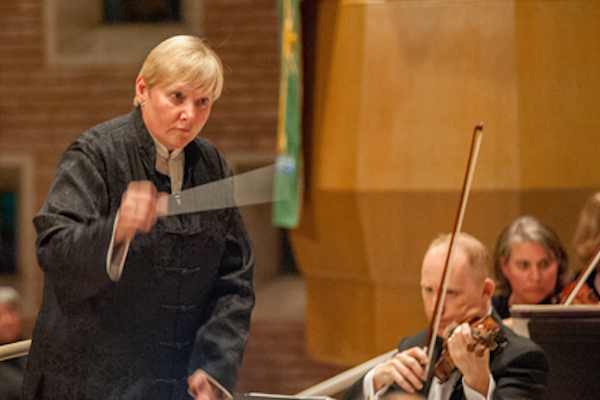
Metropolitan Orchestra highlights the change makers
By Gary Scott
The history of music is the story of the changes and evolution that have transformed music across the centuries. Sometimes, too, music itself charts the story of change and evolution, perhaps even teaching us about the times when change erupted into rebellion. Such was the case with the opening concert of the Metropolitan Orchestra of St. Louis at its sixth season opener. Three composers -- Rossini, Mozart and Mendelssohn -- demonstrated the evolution of musical style and of political and religious fervor, all under the baton of Music Director Wendy Lea.
In the years leading up to the French Revolution, the character of the wily servant Figaro in plays by Pierre Beaumarchais helped incite the populace to disdain of the nobility. Mozart had already immortalized Figaro in his opera The Marriage of Figaro. In 1792, the year after Mozart's death, Gioachino Rossini, the composer who would bring even greater notoriety to the Figaro legend, was born. In 1817 Rossini penned his wildly successful opera, [The Barber of Seville. The overture, which opened the program, is a standard of orchestral repertoire and remains a firm crowd pleaser.
W. A. Mozart's Symphony No. 36 in C Major, Linz, K.425, the middle work on the program, was conceived and written in the space of four days in 1783 as the composer visited the court of Count Johann Anton Thun of Linz, Austria. Born with a rebellious spirit to begin with, Mozart added his own special touch to the Symphony by opening it with a slow introduction. Although it is difficult to imagine an orchestra without flutes, Mozart decided to omit them from this symphony. (He was known to have a distaste for the instrument, but that is likely due to the fact that the flute of his day was a much more awkward instrument than its graceful counterpart today.) However, he made considerable use of percussion and trumpets in the work, even in the slow movement.
Before Rossini had even reached the age of 20, Felix Mendelssohn was born in Germany in 1809. The Mendelssohns were a renowned Jewish family who fostered the explosive musical careers of Felix and his sister Fanny. Some rather odd parallels exist between Mendelssohn and Mozart: Both were phenomenal keyboard prodigies, both had sisters who were also musically talented, and, sadly, both died while still in their thirties.
Fearing prejudice that might harm Felix's career, the Mendelssohn family made the difficult decision to convert to Lutheranism. Although the family never lost sight of their Jewish roots, Felix felt compelled to embrace the Protestant tradition that had rapidly gained prominence in much of northern Europe. In 1829 he composed his Reformation symphony in D Minor, the concluding work on the program, honoring the 300-year commemoration of the Protestant Reformation. The work is famous for its use of the hymn "A Mighty Fortress" in its closing movement.
After less than six years, the Metropolitan Orchestra continues to expand its impact on the St. Louis arts community with its professionalism and its ongoing commitment to young people. Moreover, the orchestra has championed traditional repertoire since its inception. Too often these days, orchestras are bypassing many of the traditional staples of musical literature in favor of contemporary works, but in so doing they are failing to realize the importance of developing a common musical language and vocabulary that will foster the formation of new generations of listeners. A concert such as this demonstrates the invaluable contribution of "traditional" music as a teacher of history, geography, philosophy and artistry. MOSL has instituted a "Sharing the Music Stand" program that provides talented young musicians with the invaluable opportunity to perform alongside professional musicians within the orchestra. The convenient and accessible auditorium at First Presbyterian in Kirkwood has also greatly aided in bringing serious music to the people.
The woodwind section of the Metropolitan Orchestra shined particularly brightly in this concert, exhibiting a bold yet carefully honed lyricism with superb intonation. However, all the sections of the orchestra display fine technique and careful attention to musical detail. The close working relationship between Wendy Lea and Conductor Laureate Allen Larson is clearly evident. Although orchestras by their very nature are designed to showcase the harmonic relationships of multiple instruments, the linear qualities of melody and rhythm are the guiding force that direct the musical message. The musicians of MOSL clearly show an awareness of line, accuracy and expression.
The next concert in this season will take place on November 5, featuring music inspired by the Hispanic tradition.


